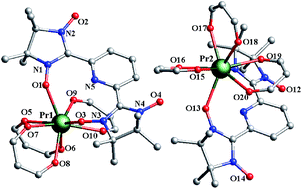A series of heterospin complexes based on lanthanides and pyridine biradicals: synthesis, structure and magnetic properties†
Abstract
The combination of anisotropic LnIII ions and organic biradicals results in six isomorphous complexes, namely, [Ln(hfac)3(NITPymbis)2]2 (Ln = Pr(1), Nd(2), Sm(3), Gd(4), Tb(5), Dy(6); hfac = hexafluoroacetylacetone; NITPymbis = (1,3-bis-(1′-oxyl-3′-oxido-4′,4′,5′,5′-tetramethyl-4,5-hydro-1H-imidazol-2-yl) pyridine). Single-crystal X-ray diffraction studies reveal that each of them is composed of two crystallographically independent mononuclear complexes, in which one NITPymbis molecule acts as a bidentate ligand coordinated to the same LnIII ion through its two NO groups to form a tri-spin system. In all six complexes, the coordination number around the lanthanide ion is eight, and the polyhedron is a 4,4-bicappped trigonal prism. DC magnetic studies show that the Ln(III) ions interact antiferromagnetically with the directly bonding nitronyl nitroxide radicals in complexes 1–3, whereas for complexes 4–6, the Ln(III) ions interact ferromagnetically with the radicals. Especially, for complex 4, intramolecular ferromagnetic interaction between the two radicals is observed with jRad–Rad = 10.05 cm−1, and at low temperature, intermolecular ferromagnetic interaction also plays an important role. Both complexes 5 and 6 exhibit frequency-dependent ac magnetic susceptibilities at low temperature, suggesting the possible presence of slow magnetic relaxation.

- This article is part of the themed collection: RSC Advances Editors' collection: f Block Chemistry

 Please wait while we load your content...
Please wait while we load your content...